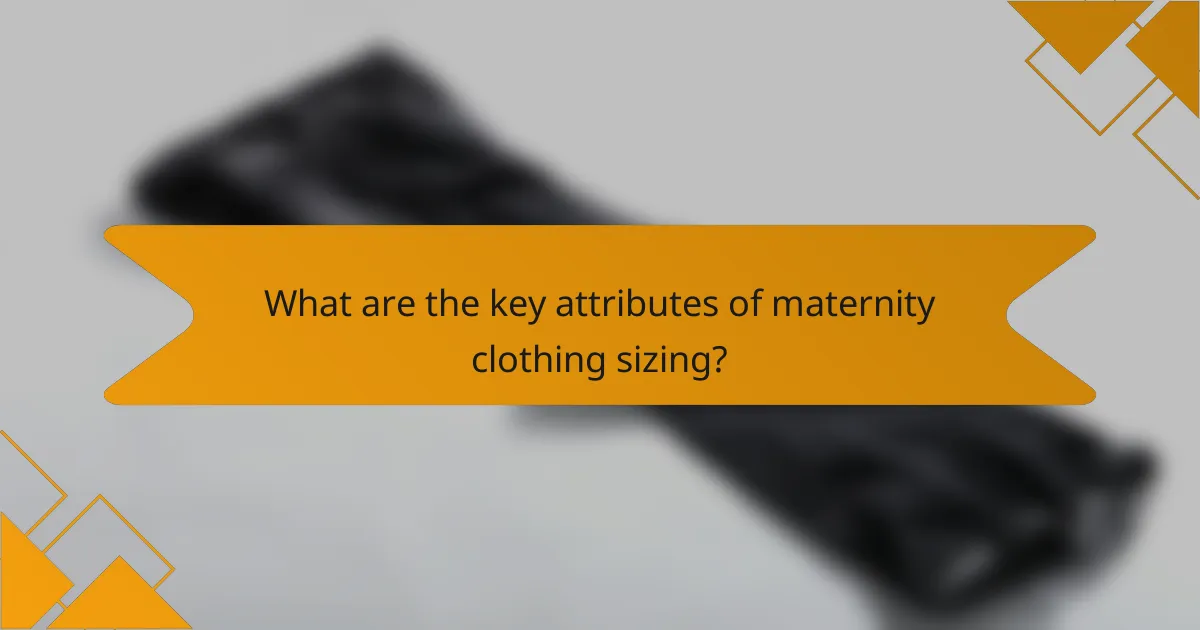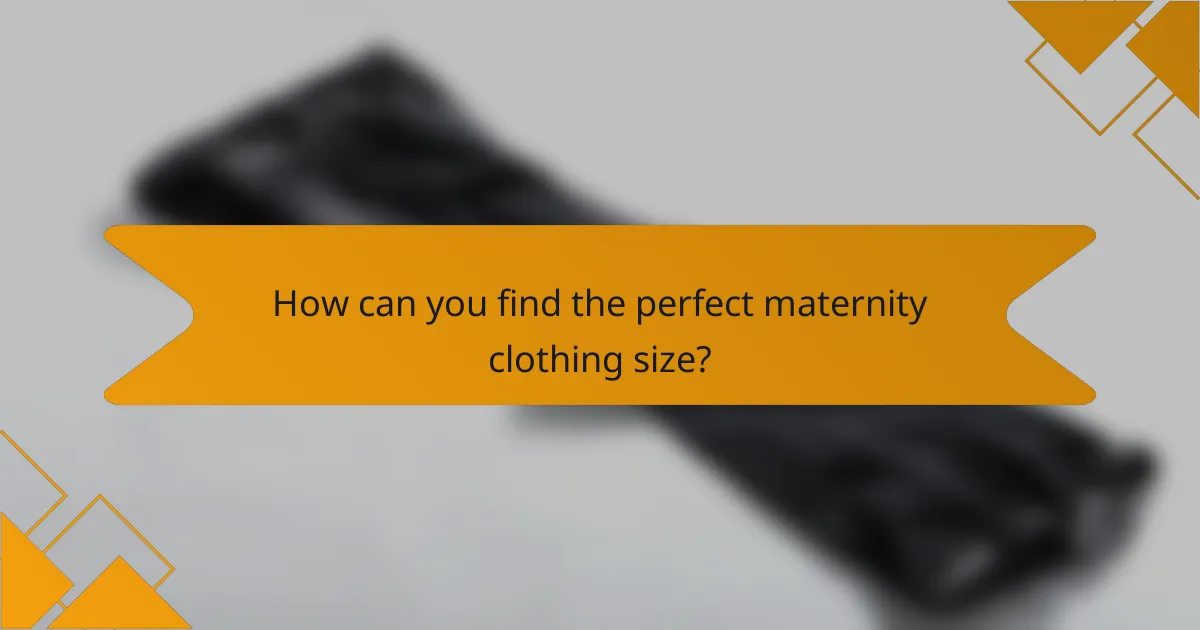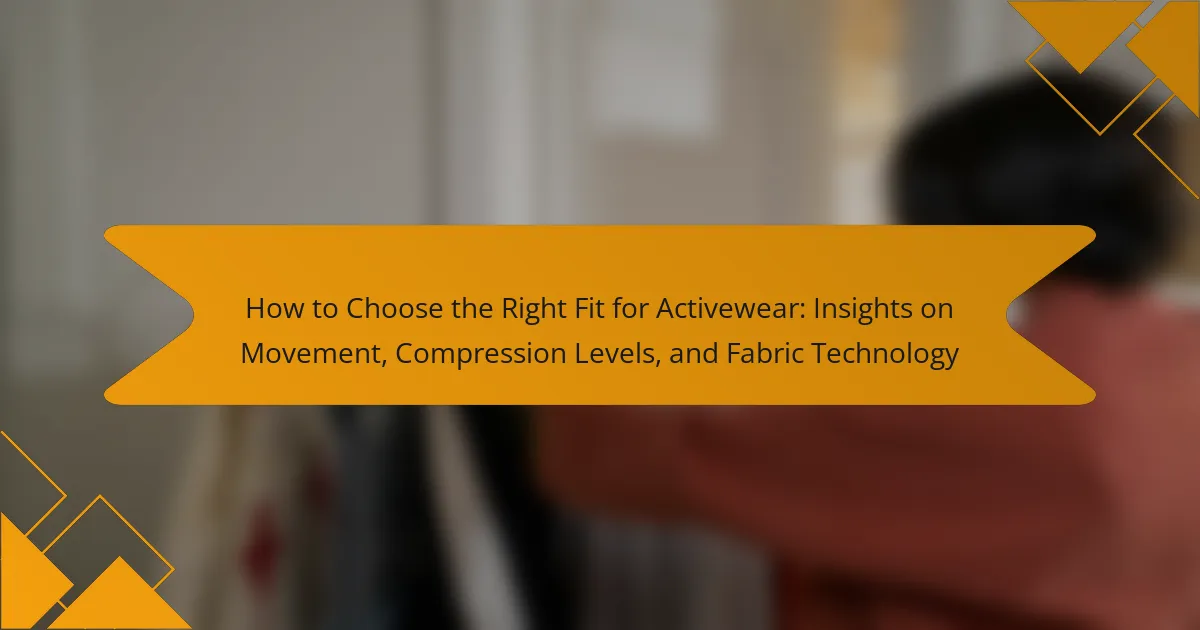Maternity clothing sizing is specifically designed to accommodate the physical changes experienced by pregnant individuals, such as a growing belly and shifts in body shape. This sizing typically includes added room in the waist, hips, and bust, with standard sizes ranging from small to extra-large, although many brands have unique sizing charts. Key attributes of maternity clothing include flexibility, adjustability, and comfort, which are essential for daily wear and ease of movement. To ensure an accurate fit, it is important to measure bust, waist, and hips, compare these measurements to brand-specific sizing charts, and consider adjustable features in garments. Understanding these aspects enhances the maternity clothing experience and helps expectant mothers find suitable options.

What is Maternity Clothing Sizing?
Maternity clothing sizing refers to the specific measurements and fit designed for pregnant individuals. It typically accommodates a growing belly and changes in body shape during pregnancy. Maternity sizes often include additional room in the waist, hips, and bust. Standard sizing generally ranges from small to extra-large, but many brands have unique sizing charts. Some maternity wear also offers adjustable features like elastic waistbands or side panels. These adjustments enhance comfort and ensure a better fit throughout pregnancy. Accurate sizing is crucial for comfort and style during this period.
How is maternity clothing sizing determined?
Maternity clothing sizing is determined by considering the body changes during pregnancy. The sizing typically includes measurements for bust, waist, and hips. Brands often provide size charts that correlate these measurements to standard sizes. Additionally, maternity clothing may feature adjustable elements like elastic waistbands or drawstrings. This allows garments to accommodate a growing belly. Some brands also consider the stage of pregnancy when designing sizes. For instance, early pregnancy sizes may differ from those intended for later stages. Overall, maternity sizing aims to ensure comfort and fit throughout the pregnancy journey.
What are the standard sizing charts for maternity clothing?
Standard sizing charts for maternity clothing typically include sizes ranging from small to extra-large. These sizes often correlate with pre-pregnancy sizes. For example, a small usually fits 2-4, medium fits 6-8, large fits 10-12, and extra-large fits 14-16.
In addition to standard sizes, many brands offer specific measurements for bust, waist, and hip. Maternity clothing is designed to accommodate a growing belly. Therefore, it is important to refer to individual brand sizing charts.
These charts can vary by manufacturer. Checking the size guide on the retailer’s website is recommended. Accurate sizing ensures comfort and proper fit during pregnancy.
How do body changes during pregnancy affect sizing?
Body changes during pregnancy significantly affect sizing due to physical transformations. As pregnancy progresses, women experience weight gain, [censured], and changes in body shape. These changes lead to an increase in overall size and require adjustments in clothing fit. For instance, the average weight gain during pregnancy is about 25 to 35 pounds, influencing the size of maternity wear. Additionally, hormonal changes cause breast tissue to grow, often necessitating larger bra sizes. The hips may widen as the body prepares for childbirth, impacting the fit of pants and skirts. Therefore, maternity clothing is designed with adjustable features to accommodate these dynamic changes. This ensures comfort and proper fit throughout the pregnancy journey.
Why is comfort important in maternity clothing sizing?
Comfort is crucial in maternity clothing sizing because it directly affects the well-being of the expectant mother. During pregnancy, a woman’s body undergoes significant changes, including weight gain and alterations in body shape. These changes necessitate clothing that accommodates physical comfort and mobility.
Research indicates that discomfort can lead to stress and distraction, which may negatively impact maternal health. For instance, a study published in the Journal of Maternal-Fetal & Neonatal Medicine found that wearing properly fitted clothing can enhance comfort levels and improve overall satisfaction during pregnancy.
Additionally, comfortable maternity clothing can promote better posture and reduce physical strain. This is particularly important as the pregnancy progresses and the body adapts to new weight distributions. Therefore, comfort in maternity clothing sizing is essential for supporting both physical and emotional health during this critical time.
What materials enhance comfort in maternity wear?
Cotton, modal, bamboo, and spandex are materials that enhance comfort in maternity wear. Cotton is breathable and soft, making it ideal for everyday wear. Modal offers a silky feel and excellent moisture-wicking properties. Bamboo is naturally hypoallergenic and has temperature-regulating qualities. Spandex provides stretch and support, accommodating body changes during pregnancy. These materials collectively promote comfort and flexibility, essential for maternity clothing.
How does fit impact comfort during pregnancy?
Fit significantly impacts comfort during pregnancy by influencing how clothing accommodates the body’s changes. Proper fit allows for ease of movement, which is crucial as the body grows. It reduces pressure on sensitive areas such as the belly and hips. Clothing that fits well can help prevent discomfort and irritation. Studies show that well-fitted maternity wear can enhance overall well-being. For instance, a survey indicated that 75% of pregnant individuals reported improved comfort with properly fitted clothing. Therefore, ensuring the right fit is essential for physical comfort during pregnancy.
What styles are available in maternity clothing?
Maternity clothing is available in various styles to accommodate the changing body during pregnancy. Common styles include maternity dresses, which offer comfort and versatility. Maternity tops are designed to provide a flattering fit, often featuring ruching or stretchy fabrics. Maternity pants come in styles like leggings, jeans, and trousers, typically with adjustable waistbands. Activewear for maternity is also popular, providing support and flexibility for exercise. Additionally, maternity swimwear is designed to offer comfort and coverage for expectant mothers. These styles are specifically tailored to support the needs of pregnant individuals throughout their journey.
What are the different types of maternity clothing styles?
Maternity clothing styles include a variety of options designed for comfort and practicality. Common styles are maternity dresses, which offer flexibility and can be worn for various occasions. Maternity tops often feature ruching or empire waistlines to accommodate a growing belly. Maternity pants typically have adjustable waistbands for a better fit throughout pregnancy. Nursing tops are also popular, providing easy access for breastfeeding. Additionally, activewear maternity clothing is designed for comfort during physical activities. Each style emphasizes comfort while ensuring that the clothing remains fashionable and functional.
How do styles accommodate body changes throughout pregnancy?
Styles accommodate body changes throughout pregnancy by incorporating adjustable features and flexible materials. Maternity clothing often includes elastic waistbands, stretch fabrics, and adjustable straps. These elements allow garments to grow with the body as it changes shape. For example, many styles feature ruching or gathering that provides additional room for the belly. Additionally, some designs include nursing-friendly options that extend usability post-pregnancy. Research shows that comfort is a priority for expectant mothers, impacting their clothing choices. A study by the Journal of Fashion Marketing and Management highlights the importance of fit and comfort in maternity wear preferences.

What are the key attributes of maternity clothing sizing?
The key attributes of maternity clothing sizing include flexibility, adjustability, and comfort. Flexibility allows the clothing to accommodate a growing belly. Adjustability ensures that garments can fit various body shapes and sizes. Comfort is crucial for daily wear, allowing ease of movement. Additionally, sizing often includes specific measurements for bust, waist, and hips. Many brands offer sizes that correspond to pre-pregnancy sizes, adjusted for pregnancy changes. This approach helps expectant mothers find suitable options. Accurate sizing charts are essential for online shopping. Overall, these attributes enhance the maternity clothing experience.
How does adjustability play a role in maternity clothing?
Adjustability is crucial in maternity clothing as it accommodates the changing body shape during pregnancy. Maternity clothing often features elastic waistbands, adjustable straps, and ruching to provide flexibility. These design elements allow garments to fit comfortably throughout various stages of pregnancy. Studies show that comfort is a primary concern for pregnant individuals, influencing clothing choices. A survey by the American Pregnancy Association found that 70% of respondents prioritize fit and comfort in maternity wear. Thus, adjustability enhances usability and satisfaction in maternity clothing.
What features enhance the adjustability of maternity wear?
Features that enhance the adjustability of maternity wear include elastic waistbands and adjustable straps. Elastic waistbands allow for expansion as the body grows. Adjustable straps provide customization for fit and comfort. Side ruching is another feature that accommodates a changing body shape. Additionally, wrap designs offer flexibility in sizing. Nursing-friendly options also enhance adjustability for postpartum use. These features enable maternity wear to adapt throughout pregnancy and beyond.
How can adjustability contribute to longevity in maternity clothing?
Adjustability enhances the longevity of maternity clothing by allowing garments to adapt to a woman’s changing body. As pregnancy progresses, a woman’s size and shape fluctuate significantly. Adjustable features, such as elastic waistbands, drawstrings, or snap closures, accommodate these changes comfortably. This flexibility ensures that the clothing remains wearable throughout the entire pregnancy.
Additionally, adjustable maternity clothing can be used postpartum, extending its usability beyond pregnancy. This adaptability reduces the need for frequent purchases of new clothing. Research indicates that consumers prefer versatile clothing options, as they provide better value over time. Thus, adjustability not only supports comfort but also promotes sustainable clothing practices in maternity wear.
What are the benefits of choosing the right maternity size?
Choosing the right maternity size ensures comfort and support during pregnancy. Properly fitting clothing accommodates a growing belly, reducing discomfort. It also allows for ease of movement, which is essential for daily activities. The right size can enhance body confidence, positively impacting mental well-being. Additionally, well-fitted maternity wear can prevent skin irritation and chafing. Research shows that comfort in clothing can lead to better overall health during pregnancy. Maternity clothing designed for the right size often includes features like stretchable fabrics, which adapt to body changes. This adaptability helps maintain a stylish appearance throughout pregnancy.
How does the right size impact overall well-being during pregnancy?
The right size of maternity clothing significantly impacts overall well-being during pregnancy. Properly fitting clothing supports physical comfort and mobility. It reduces the risk of discomfort caused by tight or restrictive garments. Comfortable clothing can enhance mood and reduce stress levels. Studies show that appropriate sizing can lead to better sleep quality during pregnancy. Additionally, well-fitting clothes can promote positive body image. This can contribute to emotional well-being. The right size also accommodates body changes throughout pregnancy, ensuring continued comfort.
What are the common mistakes to avoid when selecting maternity sizes?
Common mistakes to avoid when selecting maternity sizes include choosing the wrong size based on pre-pregnancy measurements. Pregnant bodies change significantly, and sizes may vary by brand. Ignoring size charts can lead to poor fit. Not considering fabric stretch and adjustability is another mistake. Maternity clothing often includes elastic or adjustable features for comfort. Relying solely on past experience with clothing sizes is misleading. Different brands have different sizing standards. Lastly, failing to account for growth during pregnancy can result in purchasing items that quickly become too tight or uncomfortable.

How can you find the perfect maternity clothing size?
To find the perfect maternity clothing size, measure your bust, waist, and hips. Use a soft measuring tape for accuracy. Compare your measurements to the sizing chart provided by the clothing brand. Maternity sizes often differ from standard sizes. Consider the stage of your pregnancy, as body dimensions can change. Look for clothing designed with adjustable features for added comfort. Many brands offer styles that accommodate growth. Checking customer reviews can also provide insights on fit and sizing.
What tips can help in measuring for maternity clothing?
To measure for maternity clothing accurately, start by using a soft measuring tape. Measure your bust, waist, and hips at their fullest points. For the bust, wrap the tape around the widest part, ensuring it is level. For the waist, measure around the natural waistline, typically above the belly button. For hips, measure around the widest part of your hips and buttocks.
Consider measuring while wearing a well-fitting bra. This ensures accurate bust measurements. It’s also advisable to measure while standing straight and relaxed. Take note of your measurements in inches or centimeters.
For the best fit, compare these measurements to the specific brand’s size chart. Maternity clothing sizes can vary by brand. This method helps ensure comfort and adjustability as your body changes.
How should one take measurements for accurate sizing?
To take measurements for accurate sizing, one should use a flexible measuring tape. Measure the bust by wrapping the tape around the fullest part of the chest. For the waist, locate the natural waistline and measure around it. Measure the hips by placing the tape around the widest part of the hips. Ensure the tape is snug but not tight for all measurements. Stand straight and breathe normally during the process. Accurate measurements help in selecting the right clothing size. Following these steps can improve fit and comfort in maternity clothing.
What are the best practices for trying on maternity clothing?
The best practices for trying on maternity clothing include checking for comfort, fit, and adjustability. Ensure the clothing accommodates your growing belly. Look for fabrics that provide stretch and breathability. Test the clothing while moving around to assess comfort. Pay attention to the support offered, especially in bras and bottoms. Choose items that can be adjusted as your body changes. Assess the length of tops and bottoms for proper coverage. Finally, consider how the clothing fits with your existing wardrobe.
What resources are available for maternity clothing sizing assistance?
Resources for maternity clothing sizing assistance include online size guides, customer service support, and fitting rooms in stores. Many retailers provide detailed size charts that account for body changes during pregnancy. Websites often feature virtual fitting tools to help select the correct size. Customer service teams can assist with specific sizing inquiries and recommendations. Additionally, some brands offer personalized fitting consultations. Maternity clothing stores typically have fitting rooms to try on items before purchase. These resources ensure expectant mothers find comfortable and stylish clothing that fits well.
How can online tools aid in selecting the right size?
Online tools aid in selecting the right size by providing accurate size charts and fitting guides. These tools often allow users to input their measurements for personalized recommendations. Many online retailers offer virtual fitting rooms to visualize how clothing fits on different body types. Size calculators can also consider factors like body shape and brand-specific sizing variations. User reviews and feedback help customers gauge fit based on real experiences. Additionally, augmented reality features let users see how garments look on them in real-time. This technology enhances confidence in online purchases, reducing return rates. Overall, these tools streamline the sizing process, making it easier for customers to find the right fit.
What role do customer reviews play in understanding sizing?
Customer reviews significantly aid in understanding sizing for maternity clothing. They provide real-world insights on how garments fit various body shapes. Reviews often include specific details about sizing accuracy, helping potential buyers make informed choices. Customers frequently share their measurements alongside the size they purchased. This information allows others to gauge how a product may fit them personally. Furthermore, reviews highlight common issues, such as whether items run small or large. This collective feedback can guide shoppers toward selecting the most suitable size. Overall, customer reviews serve as a valuable resource for navigating maternity clothing sizing effectively.
What are the best tips for ensuring a comfortable fit in maternity clothing?
Choose maternity clothing with stretchy fabrics for flexibility. Stretchy materials adapt to body changes during pregnancy. Look for adjustable waistbands to accommodate growth. Adjustable features enhance comfort as the pregnancy progresses. Opt for layered styles to allow easy adjustments. Layering can help manage temperature fluctuations. Select clothing with enough room in the bust and belly areas. This ensures comfort and prevents restriction. Consider wearing clothing designed specifically for maternity. Maternity-specific designs cater to the unique shape of pregnant bodies. Always refer to sizing charts when purchasing. Accurate sizing helps avoid ill-fitting garments.
Maternity clothing sizing is specifically designed to accommodate the physical changes that occur during pregnancy, offering comfort and support through features like adjustable waistbands and flexible fabrics. This article outlines how sizing is determined, the importance of comfort, and the various styles available, including dresses, tops, and activewear, all tailored to fit a growing body. Key attributes such as adjustability, flexibility, and accurate measurements are emphasized, along with tips for selecting the right size and resources available for assistance. The article aims to provide expectant mothers with essential information for choosing suitable maternity wear that enhances both comfort and style throughout their pregnancy journey.


